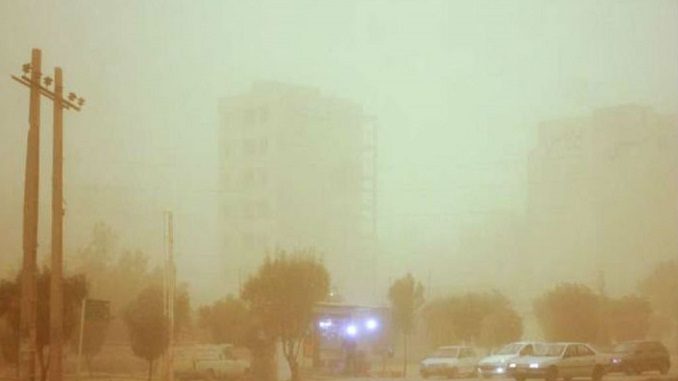
In a matter of three days, from January 19 – 21, 806 people were taken to emergency wards after a heavy dust storm hit Ahvaz, the largest city in southwestern Iran announced the director of public relations at Medical Science University, Radio Farda reports.
“On Friday, January 19, 471 visited emergency wards and clinics while 39 of them were hospitalized and nine more were taken to intensive care units,” announced Farhad Hamzehlouei.
Meanwhile, the head of Health Center in Khuzestan province reports that dust storms have significantly increased the number of people suffering from asthma and other respiratory and pulmonary complications. The volume of dust pollutant in cities like, Ahvaz, Masjid Soleiman, and Behbahan was nearly five to ten times more than the permissible average.
Air pollution in Khuzestan has reached an ominous level that, according to Khuzestan’s Prosecutor-General, Farhad Hosseini Pouya, “People are contemplating about emigrating from the province since dust storms have damaged their health and disturbed their lives”.
Iranian media have recently published many reports about the skyrocketing levels of air pollution in Iran’s metropolitan cities, including Tehran, Mashhad, Isfahan, and Ahvaz, as well as cities in Sistan and Baluchestan Province. Earlier, Iran’s vice president and the former head of the Environmental Protection Organization, Masoumeh Ebtekar had also warned of the deteriorating condition of some of the country’s wetlands and blamed Turkey for building too many dams.
“Excessive construction of dams in Turkey has plunged the Hoor al-Azim wetlands into a dangerous condition,” she said last June.
Ebtekar called on the Iranian Foreign Ministry to step in and save the wetlands from desiccation through talks with Ankara. Turkey, however, has repeatedly dismissed such comments as unfounded.
Iran has established an irrigation canal in the southwestern Khuzestan province as part of efforts to counter the menace of dust pollution hitting western and southwestern provinces bordering Iraq. Iran’s Minister of Agriculture Mahmoud Hojjati made a visit to the canal which is expected to navigate water to the regions from which sand and dust storms originate. During the visit, he was accompanied by Governor General of Khuzestan province Gholam-Reza Shariati.
“With a length of 47km, Poursharifi Canal established by Jahad Nasr Institute is set to navigate water from Karun River to the southeastern regions of Ahvaz which are the main origins of dust pollution in the province,” a Farsi report by ISNA said on Tuesday.
The lion’s share of the canal has a width of 30m, but a 10-km part of it is 50 meters wide. It transfers 20 cubic meters of water per second from Karun to 42,000 hectares of the critical regions. Hojjati also told ISNA that the government’s short-term plans to counter the dust pollution, including irrigation and tree planting in these areas, will be finished in two months, before the end of current Iranian calendar year.
Earlier in a TV interview on Monday night, Iranian President Hassan Rouhani said so far 5,000 trees have been planted in the critical regions and the figure will reach 30,000 by mid-March.
“The huge irrigation canal has been built to transfer Karun’s water to the critical regions by the next two days. Of course, it takes time for the saplings to turn into trees but we have to do something instead of sitting idle against the problem even if our efforts begin to pay off after 5 to 10 years. We already lag behind the time,” he said during the live interview aired by the state TV.
Rouhani went on to say that the water will make the regions wet and help prevent the dust and sandstorms. He also referred to the use of mulch, besides the irrigation and tree planting, as another method of controlling the dust storms.
Rouhani ordered Agriculture Minister Mahmoud Hojjati and Head of Iran’s Environmental Protection Organization (IEPO) Isa Kalantari to pay a visit to the southwestern parts of the country to address heavy dust pollution in the areas.
During a special meeting held in Tehran on Monday to examine the situation of air pollution caused by fine particles in southwestern Iran, Rouhani was briefed about the latest measures adopted to tackle the problem. He further ordered Hojjati and Kalantari to visit the areas to monitor the situation and follow up on the administration’s plans to address the dust pollution.
Kindergartens, schools and some organizations in many cities in the southwestern province of Khuzestan have been closed down in recent days because of the heavy dust pollution. According to the Environmental Organization of Khuzestan Province, the air pollution index in Ahvaz, the provincial capital, has breached the “hazardous” level upper limit of 500, at which it stops measuring levels of PM2.5, with 53 times worse than the moderate level. A hazardous level is an alert in which everyone may experience ill effects and are advised to stay indoors.
Iranian residents in the western and southwestern provinces that border Iraq face a growing trend in the influx of fine particles, which are generated by drought-hit marshlands in neighboring countries. The disruptive dust storms have pushed pollution in those border areas to alarming levels in recent years, raising health concerns.
The particles, carried by winds, can penetrate the lungs and enter the bloodstream, causing serious diseases such as lung cancer, asthma, and heart problems.
